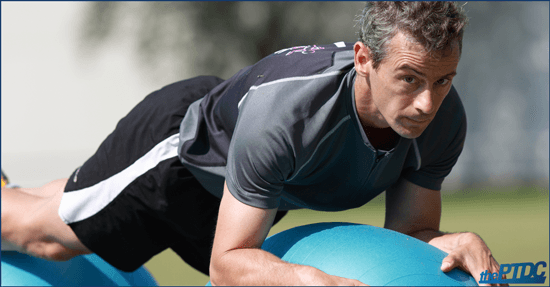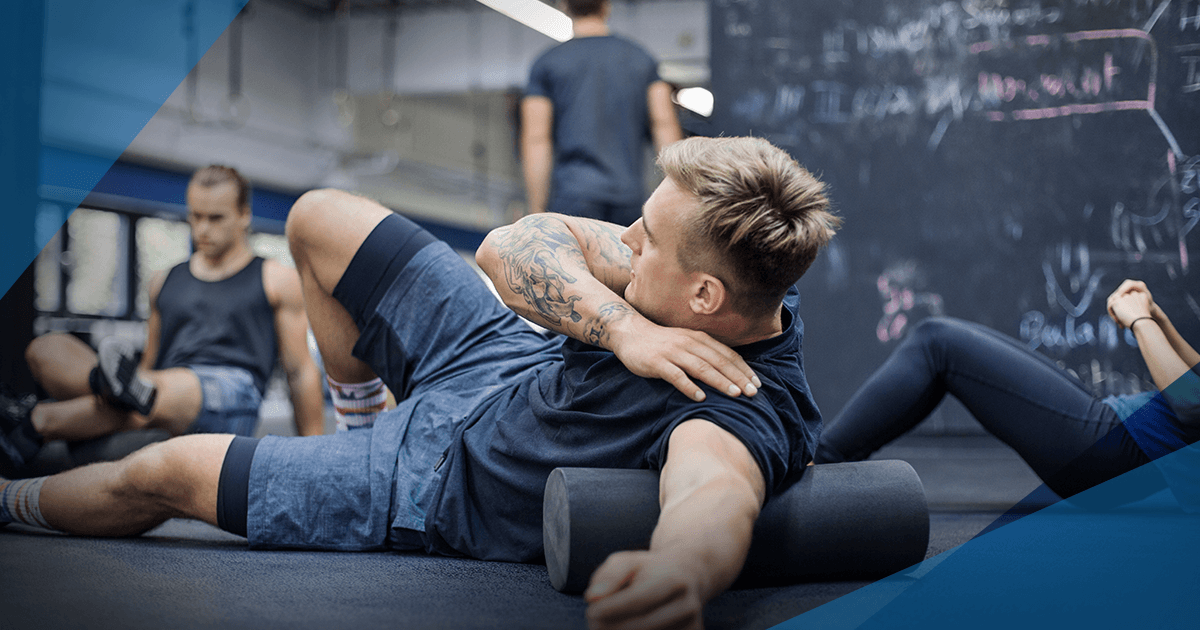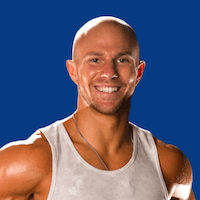By now, if you aren't using the Functional Movement Screen (FMS) or haven't even heard of it, it's safe to say that you are behind the functional training curve -- or training curve in general.

This ... is not corrective exercise.
The importance of an athlete's current level of functionality can't be understated. Function is king! That being said, it's what you do after the Functional Movement Screen that makes the biggest impact on functionality and performance.
Enter corrective exercise. 90% of the gains that are earned using the Functional Movement Systems are through the prescription of corrective exercises.
As an ex-high school and collegiate strength coach, I appreciate that time with your athletes is at an absolute premium. Busy training schedules force us as coaches to prioritize our programming and emphasize the biggest "bang for your buck" movements and training strategies.
There isn't a (smart) coach out there that would choose to program corrective exercises in place of loaded multi-joint strength or power movements for an athlete who is symmetrical and within a functional scoring range to train that specific movement.
But it's not about performance OR corrective. The best coaches out there, the ones keeping their teams healthy and performing on the field at the highest level, realize that correctives fuel performance training. These coaches use corrective exercise training with performance training synergistically within the same training period to optimize results.
Implementing the FMS with a private training client is vastly different from programming the FMS into a large group training setting such as high school, collegiate, or professional athletics. With an individual client, every move they make under your watch should be planed and programmed for his or her specific needs and goals.
As coaches, we try to bring that same mentality to the large group training setting as best as we can, but for the most part, it can't be reproduced in the same manor due to the sheer size of the groups. This is where the screening portion of the FMS and the data it generates provides a path to implement the system for every athlete, no matter the current functional level. If even a single athlete falls through the cracks of our program development, we, as coaches, did not do our job. Let's get it right!

How to apply the screen and corrective exercise differs with the size of the group.
Using FMS Scoring To Program Corrective Exercise
FMS score breakdowns allow us to group similar scoring athletes together based on two main criteria: dysfunctional movement patterns (scoring a 1 on any of the 7 screening procedures) and asymmetries.
Correcting for both dysfunction and asymmetries should be a primary goal in any corrective exercise program. Simply put, our main objective as coaches and movement specialists are to get all individuals to perform fundamental movements with a score of symmetrical 2's in order to train without restraints. We'd be doing a disservice to our athletes by loading dysfunctional movement patterns. Loading up a poor pattern increases the risk of injury and also ingrains an even less functional movement strategy for the specific pattern being performed.
I've seen time and time again that 80% of our athletes can be remediated with the same exact corrective exercises and achieve optimal results doing so. Knocking out that large of number of athletes from a corrective standpoint allows more freedom for coaches to focus on higher-ranking priorities for that specific group. The 80% getting the same correctives is the easy part. Let's dive a bit further into how to tackle the 80% from a corrective standpoint.
Preparation for Training: The Warm Up
The foundation of any training session is the warm-up. For those athletes who fall within the 80%, which can train without any major movement dysfunctions or asymmetries, I use the same progressive warm up every time they walk into the weight room. Think of this group of athletes as having the GREEN LIGHT to train, and train hard.

Time to warm up.
Our daily prep work follows a precise plan:
Soft Tissue Work -> Dynamic Warm Up/CNS Preparation-> Corrective Exercise Training
Our self-soft tissue work can consist of 5-7 minutes on a foam roller, lacrosse ball or trigger point tool. Full body soft tissue work is completed before each training session. There can be daily variances depending on what soft tissue needs the most attention and work for an individual. Each athlete will hit the same regions in the same order, but the time they spend on each tissue will be variable. Here is the program I have had a tremendous amount of success with for soft tissue work:
https://www.youtube.com/watch?v=8caF1Keg2XU
The dynamic warm-up is a pivotal aspect of the overall preparation for a successful training session. Using a full body dynamic warm-up consisting of multi-joint movements, single joint movements for areas of special emphasis and raising the systemic bodily temperature, all play a role in prepping the body to throw around some serious loads when training demands become more challenging.
The most commonly overlooked component of the dynamic warm-up is the preparation of the central nervous system (CNS). Think of prepping the CNS like greasing your nerves for optimal conduction velocity. The faster a nerve can signal a motor unit through our nervous system, the better coordinated and executed that movement will be.
I vary my prescriptions of dynamic warm ups according to sport-specific needs of athletes, specific goals, and areas needing extra emphasis and work. Here's a general dynamic warm up I use for fitness training clients (along with myself!):
- Striders- 1o per leg
- Rear Foot Elevated Rectus/Psoas Stretch- 30sec per leg
- Side Lying Wind Mills- 8 per arm
- Alternating Forward Lunge to Overhead Reach- 5 per leg
- Hip Thrust- 10
- Scapular Wall Slides- 10
- Cable Roped Face Pulls- 20
- Seal Jacks- 20
After your self-soft tissue work and dynamic warm-up, the optimal physical learning environment has been achieved. It's important to note that corrective exercise training needs to be completed under the same conditions as the functional task at hand in order to enhance motor learning. If you complete soft tissue work and warm-up dynamically before you hit the field, you better be using the same preparatory procedures before your correctives. The law of specificity holds true for everything you do; corrective exercises are no special exception.
After soft tissue and dynamics, the 80% that are not limited will spend an additional 6-8 minutes completing a corrective exercise sequence specific to that day's training session. That means if you're programming an upper body power emphasis day, prescribe corrective exercises specific to shoulder mobility, trunk stability, and rotary stability.

This should become automatic, but just to reiterate, corrective exercises should be specific to the movements of the days training session. Correctives for an active straight leg raise on a day where bench press is the money movement, can be somewhat helpful in overall athletic development, but when time is at a premium, shoulder mobility is your best bet.
Key Point: Groove technique and muscle/CNS activation with your warm up specific to your key movements for the day.
READ ALSO: What Is Anterior Pelvic Tilt, and How Do I Fix It?
Programming For The Dysfunctional Athlete
So far, using this program, we've spearheaded a majority of your athletes with corrective exercises that will maintain their current functional capacity, and even help move them towards a higher level of performance on the field and in the weight room. The 20% of dysfunctional athletes that you're coaching fall into a very similar program from a movement preparation and warm-up standpoint.
These athletes can complete the same self soft tissue work and dynamic warm-up as the 80% of functional athletes we just talked about. These athletes will absolutely receive benefit completing soft tissue and CNS work, along with the functionally able to train group, so the time devoted to these activities are not wasted. The separation between the 80% functional group, and the 20% dysfunctional group happens when we delve into the corrective exercises.
The athletes in the dysfunctional group are scoring low on the FMS for a specific reason. Low scores just don't come out of nowhere. Most of the time, there are huge negative influences that cause the functional capacity to be so low. This dysfunctional pattern or asymmetry in movement needs to be the focus of a training program for a few reasons.
The first reason to focus first on movement correction is that it will decrease the chance of injury during training or sport. This one is big, so to review:
Correcting A Dysfunctional Pattern Will Decrease Risk Of Injury!
Nothing else matters if the athlete can't compete. You can have an athlete who holds the top squat on the team, but if that squat was loaded on a dysfunctional pattern and caused injury, who really cares about the damn squat record?
Secondly, remediation of movement helps us, as coaches, be more effective and efficient in our coaching cues. We've all experienced this before; an athlete just not responding to our coaching no matter how good the cues and teaching points are. If an athlete is physically incapable of completing a pristine movement, it doesn't help if you are the back-to-back national strength coach of the year, he still won't be able to do it properly!
This can be due to a few factors such as tissue extensibility deficits, motor control problems or stability issues. Identifying the athletes that you can coach, and the ones who need work before coaching can successfully take place, will maximize your efficiency, and help keep you sane.
Remember, it's the athletes who fall through the cracks that end up being the ones sustaining injuries on the field, and under the bar. Constant assessment needs to happen in order to keep the functional group functioning, and the dysfunctional group getting more mobile and moving more efficiently in hopes of advancing to join the functional group. Corrective exercises are a great way to indirectly assess your athletes multiple times a week.
Just because an athlete earned the right to train during pre-program testing doesn't mean they're good to go for the entire training cycle in that specific grouping. One must earn the right to train on a daily basis! The golden rule states you need to move well before you move often. Assess, assess, and assess some more to position yourself and your athletes for success.

Move often
The Maintenance Phase
Maintenance of functional movement takes some serious work. Don't let it fool you, the athletes that fall within the 80% functional and ready to train grouping will be working just as hard, if not harder, than the 20% dysfunctional group needing the extra focus. The combination of sport specific training on top of heavy pre-season strength training cycles can cause the most functional athlete in the world to tighten up and loose some of their movement capacity.
In season training and maintenance phases of strength, power, and endurance pose their own challenges as well. That's why it is important to remediate all athletes with corrective exercise year round. Using low loads, high quality repetitions, and high levels of CNS activation can enhance an athlete's performance any time of the year while limiting physical demands of training. Leave no stone unturned and you'll have success with building your athletes a foundation that can weather any storm.
The implementation of the FMS within your current training program can be intimidating at first because change is so damn hard. The field of strength and conditioning is always advancing, and unless you want to fall behind, you better become educated with what is a fad, and what systems actually change the game for the better. Don't let the fear of change keep you from making the Functional Movement Systems part of your daily operation, but more importantly, your belief systems as a movement specialist and strength and conditioning coach.











